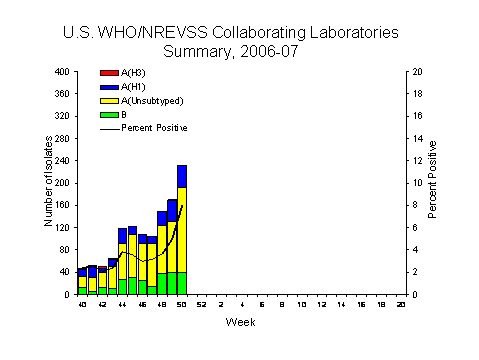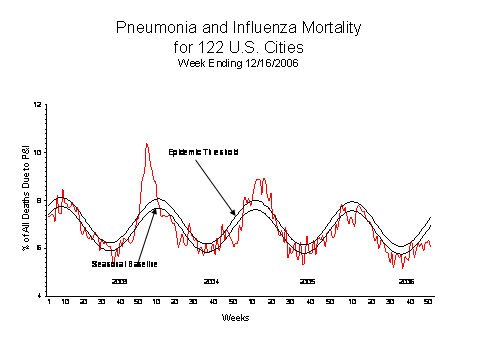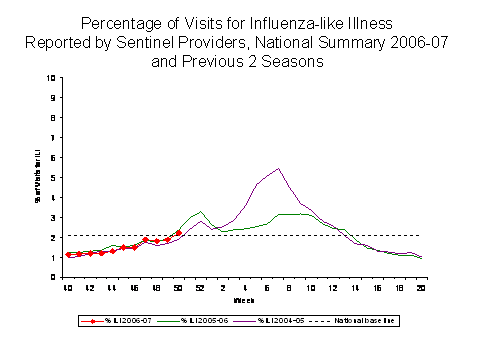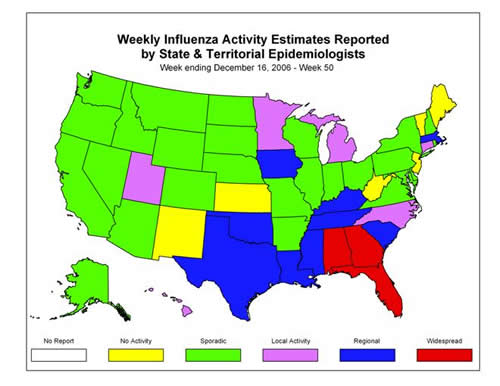Thanks to Siam posting at PlanforPandemic
6 area children with flu on life support (in Birmingham, Alabama)
Number, severity of early cases alarm officials
Friday, December 22, 2006
LISA OSBURN News staff writer
Six children are on life support at Children's Hospital fighting severe cases of influenza, hospital officials said. The severity of the cases, many developing in the past two weeks, has raised concerns in Birmingham's pediatric medical community, said Dr. David Kimberlin, who specializes in pediatric infectious diseases at UAB.
"It is not the volume and not even the time of year that is jumping out at us," he said. "It is more that, for a number of otherwise healthy children, they are ending up on life support from the flu. The number of times that is occurring - it seems out of the ordinary, at least for now."
Influenza has hit Birmingham area children hard and early this year, with at least 10 reports of critically ill children, said Raenetta Ellison, influenza surveillance coordinator for the Jefferson County Health Department. Normally, cases of that number and severity are not reported until late January, February and March, she said.
Alabama elevated its weekly influenza report to the "widespread outbrea" category this week, compared with the "regional outbreak" category last week, said Katina James, an epidemiologist with the Alabama Department of Public Health. Since influenza is not a reportable disease, there are no numbers available for flu cases, she said. Her office had no other reports of severe cases like those seen in Jefferson County.
"Alabama had influenza activity earlier than most other states this year," Kimberlin said. "Right now, we and Florida and perhaps Georgia are really experiencing the largest outbreak of influenza in the country. We have a lot of children in the hospital with influenza, and that includes some very sick children in ICU." The level of life support varies among the six patients, all of whom have respiratory failure, Kimberlin said. In some cases, in addition to a ventilator, additional support is needed, such as a heart and lung bypass machine.
While most of the younger flu patients are not that severely ill, emergency rooms and doctor's offices are staying packed with sick children, he said.
I would like to know more so we can better understand what we are comparing this against," Kimberlin said. Outside of data that would better track the number of pediatric flu cases, "we are left with clinical impression. And this seems to be a particularly bad year, at least for some normal children who are getting the flu," he said.
Kimberlin, who is an associate professor of pediatrics at UAB, mentioned the 2003-04 flu season, when 153 influenza-associated deaths in children younger than 18 were reported by state health departments across the country. At that time, doctors determined that they did not know enough about how many children get sick during a flu season. Although studies and other types of surveys have been established since then, more time is needed to better compare one year with another, he said.
While the Birmingham and Jefferson and Shelby county school systems are not reporting a spike in sick students overall, there have been isolated cases of the flu hitting individual schools or classrooms, said Cindy Warner, spokeswoman for Shelby County schools.
Mt Laurel Elementary School has taken the brunt of that in Shelby County. At least two of its students have been hospitalized, one in critical condition, and the school had 80 students out sick over the past few weeks, Warner said.
Hundreds sick:
Pinson Elementary and Chalkville Elementary in Jefferson County have reported hundreds of children out sick, many with flu-like symptoms, said Nez Calhoun, Jefferson County schools spokeswoman.
Two weeks ago, the schools had 300 and 400 students out sick, many with flu-like symptoms, on a Thursday and Friday, compared with about 30 to 40 students out sick a year ago. School officials sent letters home to parents urging them to keep sick children at home, she said.
Ellison, who monitors the number and severity of flu cases with the help of participating physicians, said she is urging parents to get their children flu shots and practice good hygiene.
For the week of Dec. 10-16, 186 patients with influenza-like illness, mostly children, sought treatment with a physician participating with the Jefferson County influenza surveillance program, she said. There were 50 such patients at the same time last year.
"It's not too late to vaccinate, and please do so," Kimberlin said. "If you do come down with the flu, there are treatments available."
http://www.al.com/news/birminghamnews/index.ssf?/base/news/1166793395185660.xml&coll=2
I am going to email or call whomever I can find contact info for and try to see if they are testing for H5N1. I am sure they are; it would be totally irresponsible and negligent not to do so.
6 area children with flu on life support (in Birmingham, Alabama)
Number, severity of early cases alarm officials
Friday, December 22, 2006
LISA OSBURN News staff writer
Six children are on life support at Children's Hospital fighting severe cases of influenza, hospital officials said. The severity of the cases, many developing in the past two weeks, has raised concerns in Birmingham's pediatric medical community, said Dr. David Kimberlin, who specializes in pediatric infectious diseases at UAB.
"It is not the volume and not even the time of year that is jumping out at us," he said. "It is more that, for a number of otherwise healthy children, they are ending up on life support from the flu. The number of times that is occurring - it seems out of the ordinary, at least for now."
Influenza has hit Birmingham area children hard and early this year, with at least 10 reports of critically ill children, said Raenetta Ellison, influenza surveillance coordinator for the Jefferson County Health Department. Normally, cases of that number and severity are not reported until late January, February and March, she said.
Alabama elevated its weekly influenza report to the "widespread outbrea" category this week, compared with the "regional outbreak" category last week, said Katina James, an epidemiologist with the Alabama Department of Public Health. Since influenza is not a reportable disease, there are no numbers available for flu cases, she said. Her office had no other reports of severe cases like those seen in Jefferson County.
"Alabama had influenza activity earlier than most other states this year," Kimberlin said. "Right now, we and Florida and perhaps Georgia are really experiencing the largest outbreak of influenza in the country. We have a lot of children in the hospital with influenza, and that includes some very sick children in ICU." The level of life support varies among the six patients, all of whom have respiratory failure, Kimberlin said. In some cases, in addition to a ventilator, additional support is needed, such as a heart and lung bypass machine.
While most of the younger flu patients are not that severely ill, emergency rooms and doctor's offices are staying packed with sick children, he said.
I would like to know more so we can better understand what we are comparing this against," Kimberlin said. Outside of data that would better track the number of pediatric flu cases, "we are left with clinical impression. And this seems to be a particularly bad year, at least for some normal children who are getting the flu," he said.
Kimberlin, who is an associate professor of pediatrics at UAB, mentioned the 2003-04 flu season, when 153 influenza-associated deaths in children younger than 18 were reported by state health departments across the country. At that time, doctors determined that they did not know enough about how many children get sick during a flu season. Although studies and other types of surveys have been established since then, more time is needed to better compare one year with another, he said.
While the Birmingham and Jefferson and Shelby county school systems are not reporting a spike in sick students overall, there have been isolated cases of the flu hitting individual schools or classrooms, said Cindy Warner, spokeswoman for Shelby County schools.
Mt Laurel Elementary School has taken the brunt of that in Shelby County. At least two of its students have been hospitalized, one in critical condition, and the school had 80 students out sick over the past few weeks, Warner said.
Hundreds sick:
Pinson Elementary and Chalkville Elementary in Jefferson County have reported hundreds of children out sick, many with flu-like symptoms, said Nez Calhoun, Jefferson County schools spokeswoman.
Two weeks ago, the schools had 300 and 400 students out sick, many with flu-like symptoms, on a Thursday and Friday, compared with about 30 to 40 students out sick a year ago. School officials sent letters home to parents urging them to keep sick children at home, she said.
Ellison, who monitors the number and severity of flu cases with the help of participating physicians, said she is urging parents to get their children flu shots and practice good hygiene.
For the week of Dec. 10-16, 186 patients with influenza-like illness, mostly children, sought treatment with a physician participating with the Jefferson County influenza surveillance program, she said. There were 50 such patients at the same time last year.
"It's not too late to vaccinate, and please do so," Kimberlin said. "If you do come down with the flu, there are treatments available."
http://www.al.com/news/birminghamnews/index.ssf?/base/news/1166793395185660.xml&coll=2
I am going to email or call whomever I can find contact info for and try to see if they are testing for H5N1. I am sure they are; it would be totally irresponsible and negligent not to do so.
 </TD></TR><TR><TD width=1 bgColor=black height=1>
</TD></TR><TR><TD width=1 bgColor=black height=1> </TD><TD width=1 bgColor=black height=1>
</TD><TD width=1 bgColor=black height=1>






Comment